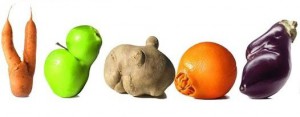By Emma Paulini – 11th Grade, Fox Chapel Area High School
 What do you think of these vegetables? Would you eat them? In the Summer of 2014, a major supermarket in France called Intermarche successfully campaigned for food salvaging, creating a program that reduced food waste by creating a special aisle for the “inglorious fruits and vegetables” that would normally be thrown out. The fruits and veggies were sold at a discounted price, and people sampled smoothies and soups made from the produce that looked funny but tasted fine. Since then, France has made it illegal for stores to throw out or destroy edible unsold food. Instead, the food will be given to charity. These are important steps to take, because about 40 percent of our food goes uneaten every year – about $165 billion worth or 240 pounds of food per person. Even with our apparent food surplus, thousands of people go hungry every day. Every simple act of food salvaging helps – people can contribute to the cause, from governments to farmers to grocery stores to you! Food salvaging is critical, easy to accomplish, economical, good for the earth, and helps others in your community and the world.
What do you think of these vegetables? Would you eat them? In the Summer of 2014, a major supermarket in France called Intermarche successfully campaigned for food salvaging, creating a program that reduced food waste by creating a special aisle for the “inglorious fruits and vegetables” that would normally be thrown out. The fruits and veggies were sold at a discounted price, and people sampled smoothies and soups made from the produce that looked funny but tasted fine. Since then, France has made it illegal for stores to throw out or destroy edible unsold food. Instead, the food will be given to charity. These are important steps to take, because about 40 percent of our food goes uneaten every year – about $165 billion worth or 240 pounds of food per person. Even with our apparent food surplus, thousands of people go hungry every day. Every simple act of food salvaging helps – people can contribute to the cause, from governments to farmers to grocery stores to you! Food salvaging is critical, easy to accomplish, economical, good for the earth, and helps others in your community and the world.
Did you know that the “best by” and “sell by” dates on foods are only suggestions for peak freshness, but don’t dictate the safety of the food? These are not government regulated markings, and most foods are still safe to eat days or even weeks after their printed dates. Before mindlessly pitching food that still looks fine, reevaluate it with a simple sniff test. If it smells as it should without any off-putting odor, it is most likely still tasty and safe to eat. To proactively prevent food spoilage, simply rearrange key items in the fridge for optimum shelf life. For example, store milk in the back of the fridge where it is colder as opposed to the fridge door. If you have fresh produce or leftovers from a meal that you might not eat within the near future, portion them out and freeze to use later. Frozen fruits and veggies can be blended into smoothies or thawed into soups, and leftovers reheat well for a quick meal. When you use what you have, your family saves time and money by preventing excess trips to the store or last minute restaurant stops. When it is time to go grocery shopping, encourage your family to write a shopping list so you’ll buy what will actually be eaten.
Saving food helps save the environment. Using what we have and preventing waste conserves space, energy, water, and more. Many resources are needed to produce, package, and ship food, and are also consumed when we throw food away. Wasted food in landfills releases methane into the atmosphere, a major contributor to global warming. By eating food instead of throwing it away, we help the environment; and every person can help. For example, if you pack your lunch, pack what you know you’ll eat so none is wasted. If you buy lunch, evaluate how much you usually eat and purchase that amount. At home, you can compost leftovers, which refuels the earth, nourishes the ground, and allows us to grow healthier plants, making a better planet.
Food salvaging strengthens communities. Recovered food can be distributed to those in poverty through organizations such as “Feeding America” or through local food banks. This promotes volunteer work, getting people out helping others. In Vancouver last May, an event fed free lunches from recovered food to more than 5000 people. People of all ages and backgrounds gathered to experience quality meals made from food that otherwise would have been thrown away, reminding everyone to think twice about wasted food. This community event got people out meeting each other, learning, and creating relationships.
Food is important to all of us, so it’s important to use it the best we can. Eating well, saving leftovers, and recognizing food’s safety and quality are ways you can help in your daily life. Food salvaging saves money, helps the community, nourishes the earth, and conserves resources. It’s something that we all can do, and every little bit counts.
Also, how fun would it be to try one of those funny looking fruits or vegetables?! We are all able to impact the world by what’s on, or rather what’s not on, our plates.

Emma Paulini is a junior at Fox Chapel Area High School. She is on the Senior Staff of her school’s literary arts magazine, is published in the Ralph Munn Creative Writing Anthology, and has received Scholastic Art and Writing Awards. Emma also enjoys dancing, cooking, and exploring the world.
Leave a Comment